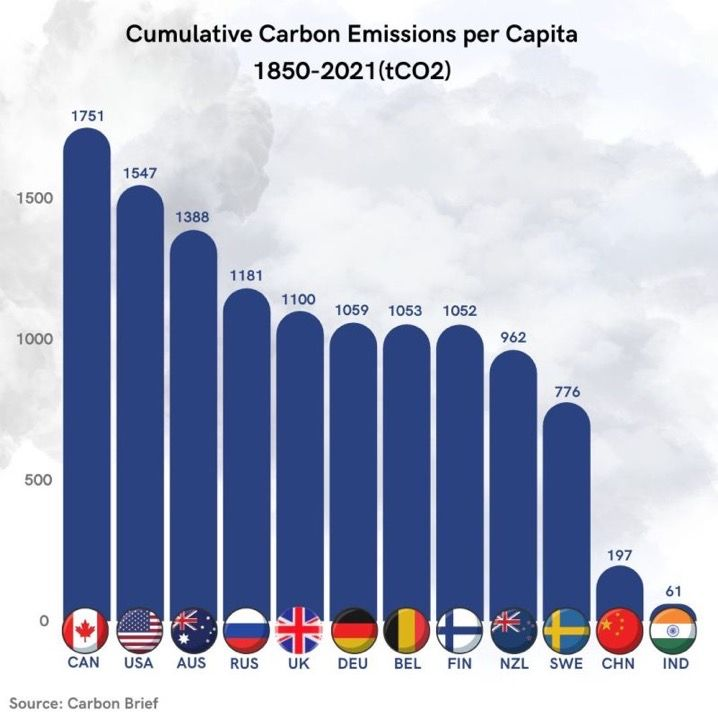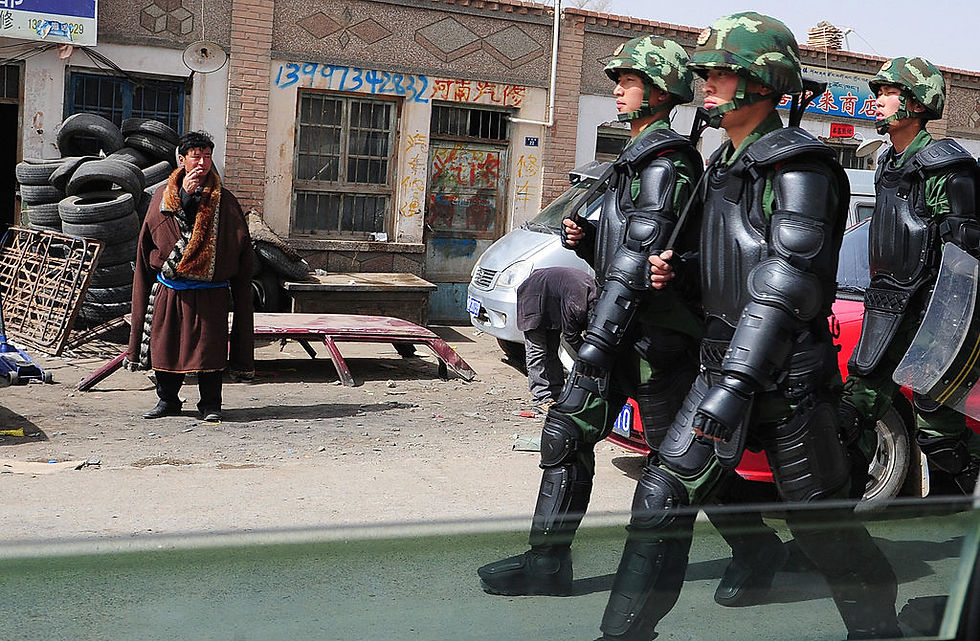One Chart shows why Climate Equity is so Important
- Aayushi Sharma

- Sep 19, 2022
- 4 min read
Updated: Sep 20, 2022
Without a historical perspective on emissions, there cannot be any real climate equity and climate justice. And without that the green transition that the world needs cannot happen.

Historical perspective shows how far the developed and developing world is from attaining climate equity and justice.
The United Nations’ Environment Programme’s Emissions Gap Report 2021 suggests that the global temperature is projected to rise to a level of 2.7C by the end of this century[1] which is well above the aspired goal of 2C agreed upon in the Paris Agreement. Now, it is important to analyse the image above with this context into consideration.
The chart highlights the per capita carbon emissions of the major contributing states from 1850-2021. The statistics on per capita emissions takes into account the greenhouse gas emissions of the countries with relation to their population. In this case, it is very significant to note that the per capita emission of the major developed countries with lesser populations accounts for the majority (39%) of the carbon dioxide emissions whereas the countries with about 42% of the world’s population (China, India, Brazil and Indonesia) contributed to 23% of the cumulative emissions from the year 1850 to 2021[2].
This particular aspect is well highlighted in the figure above when we consider Canada’s per capita CO2 emission of 1751 metric tonnes as against India’s emission of 61 metric tonnes during the same period. This chart further depicts the trend in the per capita emissions that majorly rise from the developed world as compared to the developing economies of India and China.
This is where the concept of 'climate equity' and 'justice' comes in. The rationale is that even though a handful of countries are responsible for a major proportion of carbon emissions in the world, the effects of climate change and global warming will be borne by the most vulnerable sections of the world population. The figure above and other such similar statistics point to the need for the understanding of ‘differentiated responsibilities’ when it comes to climate action. This principle of equity is not a new phenomenon, it has been a part of climate action negotiations since decades and even included in the legal treaty instruments like the Paris Agreement[3]. However, there still stands a need to implement this principle into practice, the statistics above are a case in point for the same.
What Would Climate Equity Entail?
One aspect of equity would inherently deal with the responsibility of the different states based on their contribution to the global carbon emissions and the other aspect would be the support mechanisms provided to the population likely to be adversely affected by the effects of climate change. Both these aspects point towards the need towards tangible actions in terms of climate budget and financing. One of the most fundamental aspects of equitable climate action would be an equitable distribution of budget and resource allocation towards. This would aid in developing carbon negative energy technologies[4] and also in establishing a framework to mitigate the risks of rising global temperatures in the developing world. Therefore, there needs to be a transfer of financial aid from the developed to the developing countries so as to achieve these desired goals while also upholding the principle of equity and responsibility.
However, the reality is somewhat removed from the desired expectations of equitable responsibilities. It is imperative to look into the situation of global climate financing in this case.
The Case For Climate Financing
At the 2009 UNFCCC Conference in Copenhagen, the developed countries pledged to contribute 100$ billion by the end of 2020 to the developing world so as to help mitigate the risks of climate change. In this context, the latest report of the Organisation of Economic Cooperation and Development (OECD) highlights that the contribution reached about 83.3$ billion in 2020, falling short of the pledged amount[5]. As per the estimates by the Climate Policy Initiative[6], there needs to be a rise of about 590% in finance to climate action by 2030 so as to meet the desired objectives.
These figures and statistics point to the need for greater initiative by the ‘developed’ world in building capacities within the developing countries to deal with the catastrophe of climate change. Time and again, the call of equity and justice has been coming from the voices within the developing countries. India, for example, has been at the forefront of advocating for greater support and financial flows from the ‘richer’ countries to assist in managing the climate crises. In the latest Conference of Parties (COP26) in Glasgow Prime Minister Narendra Modi significantly highlighted the need for the developed countries to take responsibility and increase the financial contributions to 1$ trillion dollars in order to navigate through the unprecedented challenges posed by climate issues. This is a significant step because even though the developing countries create mechanisms to reduce their carbon emissions, there is still a need for the higher financial resource allocation to meet the low carbon emission technology needs that arise thereof.
Taking the attention back to the chart above, it also points to the need for such assessments of carbon emissions by different countries, especially in relation to their population. This provides us with a rational and informed picture of how just a small portion of the world population is responsible for such high emissions, the consequences of which will be borne by the whole world alike.
[1] Emissions Gap Report 2021. United Nations Environment Programme. Retrieved from: https://www.unep.org/resources/emissions-gap-report-2021 [2] Simon Evans (2021) Analysis: Which countries are historically responsible for climate change? Carbon Brief. Retrieved from: https://www.carbonbrief.org/analysis-which-countries-are-historically-responsible-for-climate-change/ [3] Rosa Manzo (2021) Climate Equity or Climate Justice. Retrieved from: https://www.iucn.org/news/world-commission-environmental-law/202103/climate-equity-or-climate-justice-more-a-question-terminology [4] Going Carbon Negative. International Atomic Energy Agency (IAEA). Retrieved from: https://www.iea.org/commentaries/going-carbon-negative-what-are-the-technology-options [5] OECD Secretary General’s Statement. OECD. Retrieved from : https://www.oecd.org/environment/statement-by-the-oecd-secretary-general-on-climate-finance-trends-to-2020.htm#:~:text=29%2F07%2F2022%20%2D%20Climate,increase%20from%202018%20to%202019. [6] Global Landscape of Climate Finance 2021. Retrieved from- https://www.climatepolicyinitiative.org/publication/global-landscape-of-climate-finance-2021/








Comments